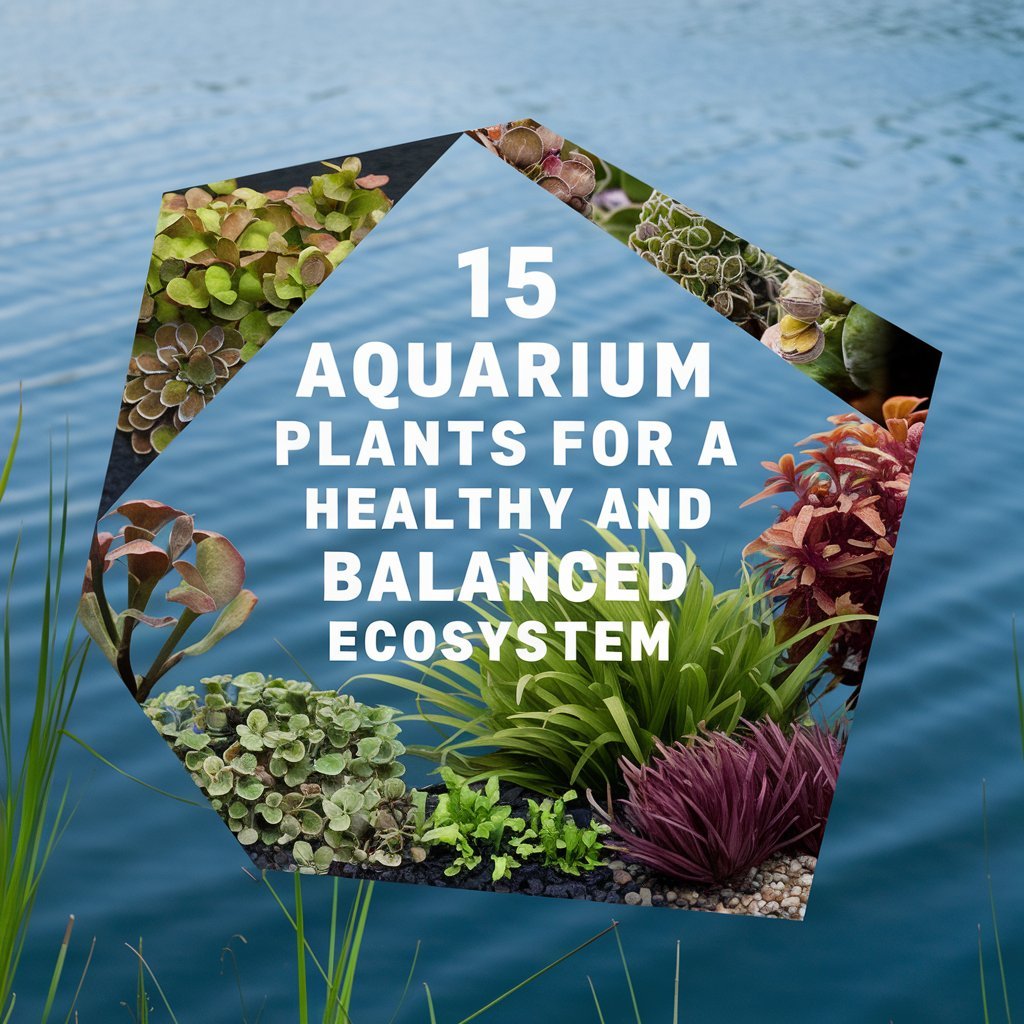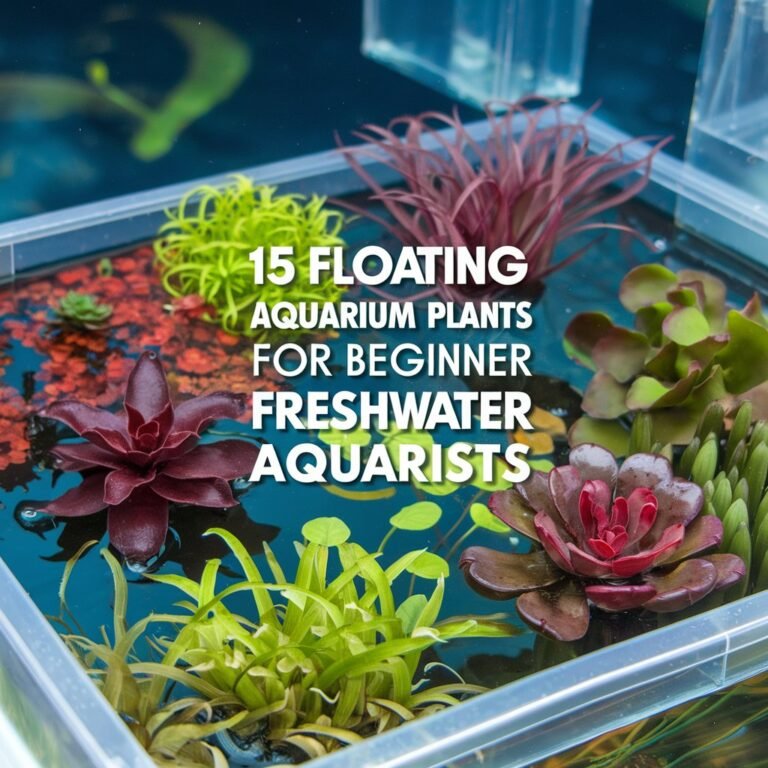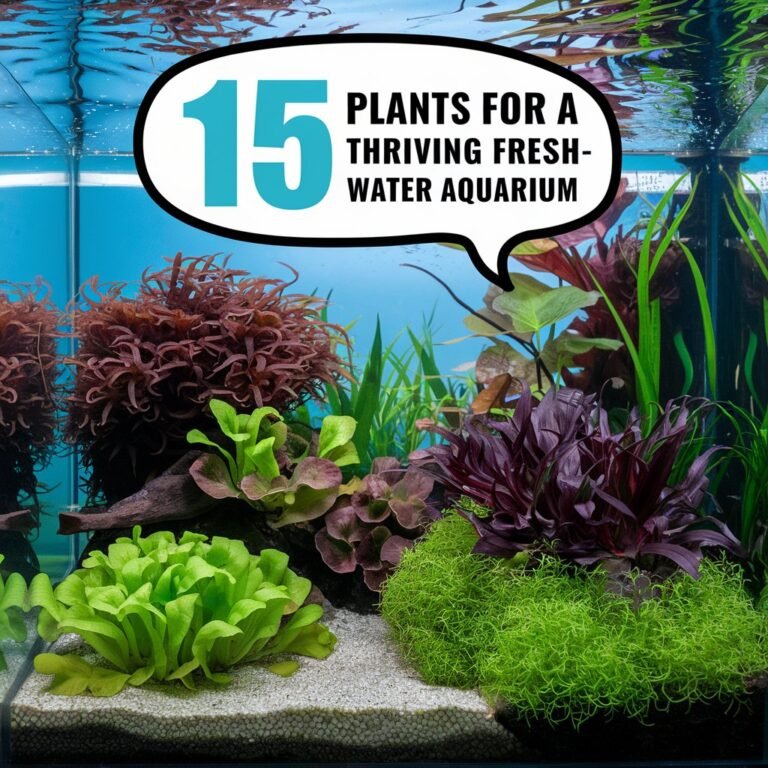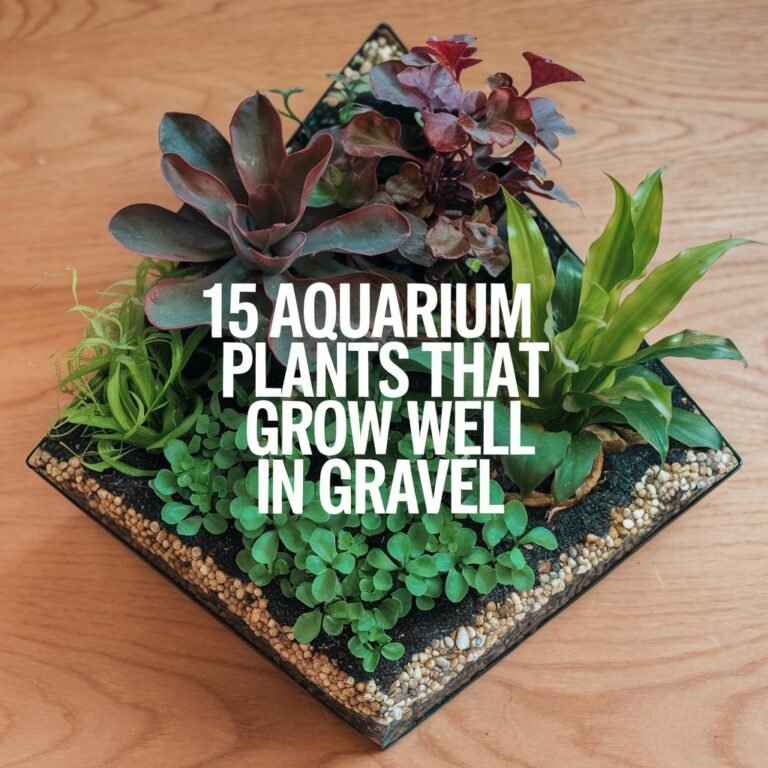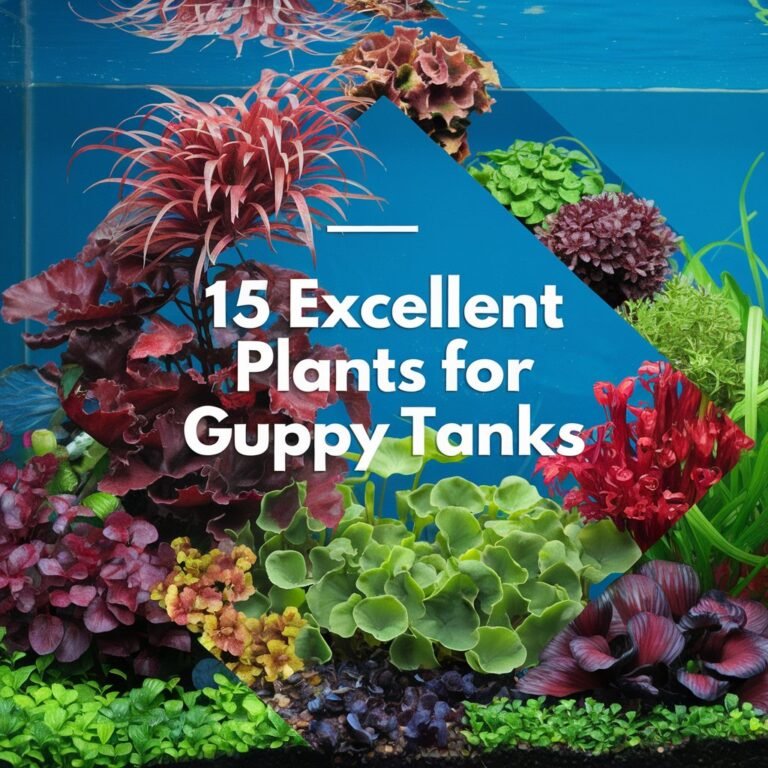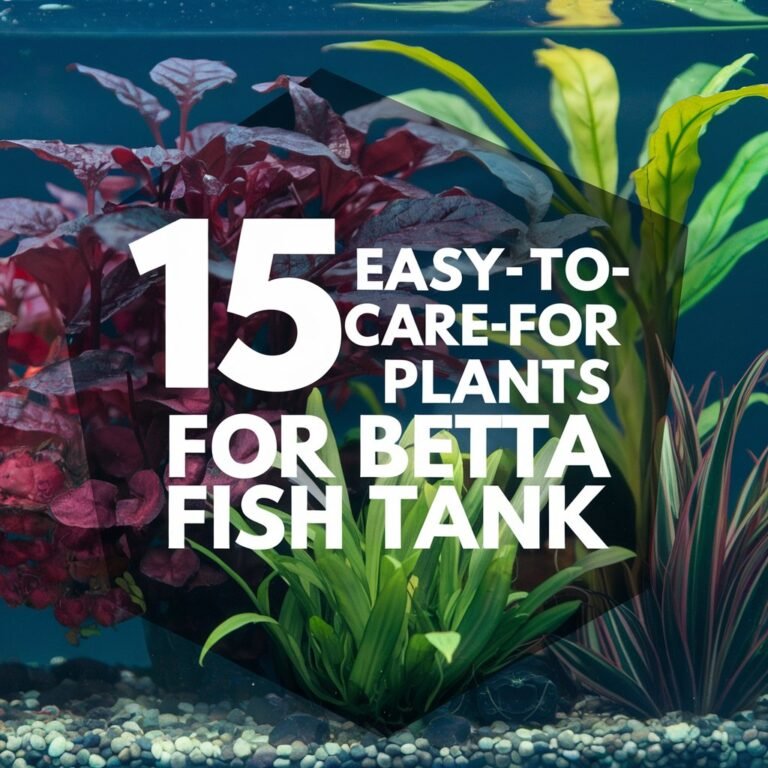15 Aquarium Plants for a Balanced Ecosystem
When it comes to creating a thriving aquarium, you know that choosing the right plants is vital for a healthy and balanced ecosystem. But with so many options available, it can be overwhelming to decide which ones to select.
You’re likely looking for plants that are easy to care for, can thrive in various lighting conditions, and promote a balanced environment for your aquatic life. We’ve narrowed down the best options for you, but before we reveal the top 15 aquarium plants for 2024, key to keep in mind is evaluating your specific aquarium needs – and that’s exactly where we’re about to start.
In A Nutshell
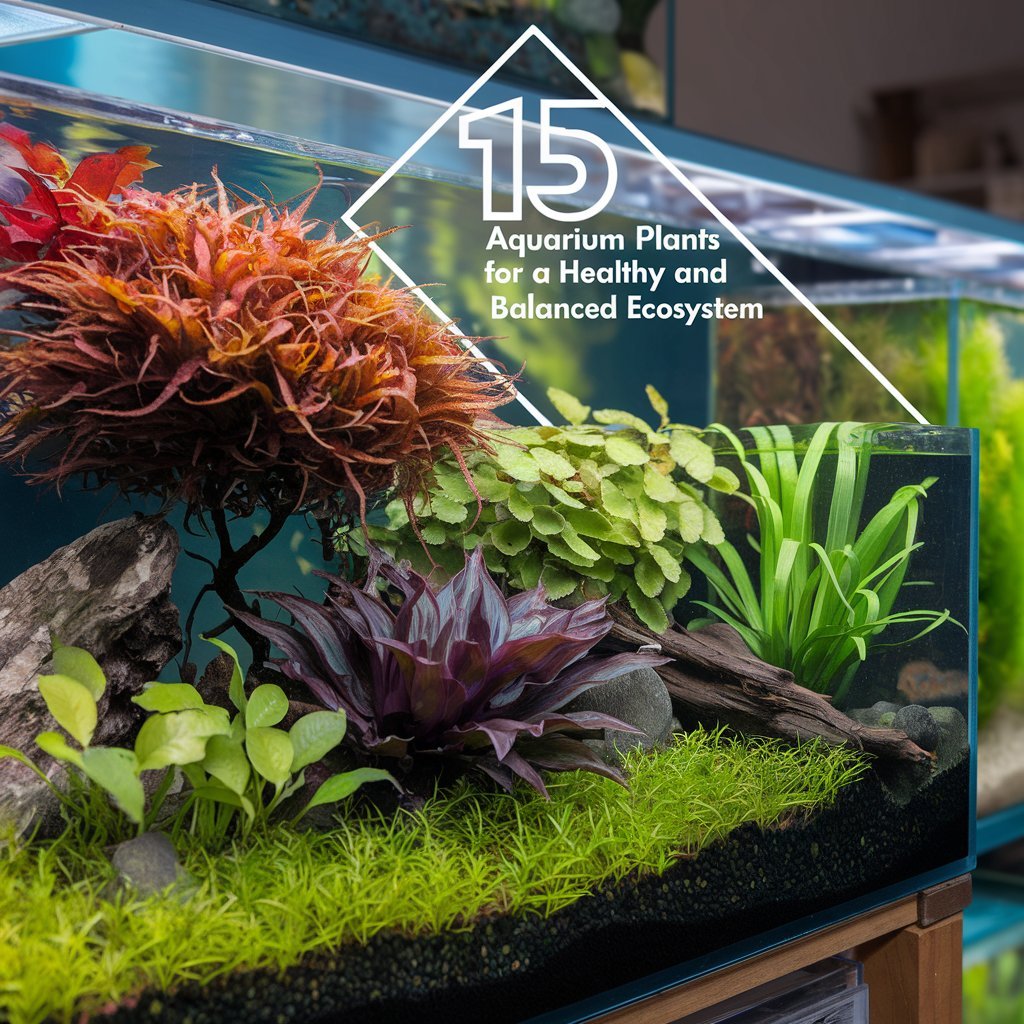
- Java Moss and Anubias Barteri are ideal for aquariums with varying lighting and water conditions.
- Amazon Swords, Dwarf Hairgrass, and Green Amazon Swords require moderate to high lighting for optimal growth.
- Regular pruning and water changes promote healthy growth in plants like Water Wisteria, Cabomba Aquatica, and Hygrophila Polysperma.
- Hornwort Coontail and Water Clover can thrive in a wide range of water temperatures and pH levels.
- Anacharis Elodea helps maintain ideal water parameters by reducing ammonia and nitrite levels.
Java Moss
A large portion of aquarium enthusiasts opt for Java Moss, a versatile, non-vascular plant, due to its adaptability and low maintenance requirements.
You’ll find Java Moss Benefits are numerous, including its ability to thrive in a variety of lighting conditions and water parameters.
This plant is also an excellent choice for aquariums with low water circulation, as it can absorb nutrients from the air and water.
When it comes to Moss Decoration Techniques, you can attach Java Moss to rocks, driftwood, or other decorations using a fishing line or a plant glue.
You can also let it float freely, creating a natural, carpet-like effect on the substrate.
Java Moss is an ideal choice for creating a natural environment, providing shelter and food for small fish and invertebrates.
By incorporating Java Moss into your aquarium design, you’ll create a balanced ecosystem that’s both aesthetically pleasing and beneficial for your aquatic life.
With proper care, Java Moss can be a valuable addition to your aquarium, providing numerous benefits for your aquatic plants and animals.
Anacharis Elodea
While maintaining a thriving aquarium, you’ll likely consider incorporating fast-growing plants like Anacharis Elodea, a submerged aquatic plant that effectively controls algae growth and maintains water quality.
This plant is a popular choice for freshwater aquariums due to its numerous benefits. Anacharis Elodea is a highly efficient water purifier, capable of absorbing excess nutrients and toxins from the water.
It’s particularly effective in controlling nitrate and phosphate levels, which can contribute to algae growth. As a fast-growing plant, Anacharis Elodea can outcompete algae for nutrients, reducing the risk of algae blooms.
It also provides a natural food source for herbivorous fish and invertebrates. In respect to freshwater benefits, Anacharis Elodea helps maintain ideal water parameters, including pH, ammonia, and nitrite levels.
By incorporating Anacharis Elodea into your aquarium, you can create a balanced ecosystem that promotes healthy plant and animal life. Regular pruning is necessary to maintain the plant’s health and prevent it from becoming too dense.
With proper care, Anacharis Elodea can thrive in a variety of aquarium environments, making it an excellent choice for aquarists seeking a low-maintenance, high-reward plant.
Amazon Swords
Proper aquarium setup demands deliberate plant selection, and incorporating Amazon Swords can significantly enhance your aquarium’s aesthetic appeal.
As a plant originating from the Amazon habitat, Amazon Swords (Echinocorys spp.) thrive in well-oxygenated and nutrient-rich environments. When choosing Amazon Swords for your aquarium, consider the specific lighting requirements for the species you select.
Most Amazon Swords require moderate to high lighting, typically in the range of 1.5-3.5 watts per gallon.
For ideal Sword maintenance, verify that your aquarium has a pH range of 6.5-7.5 and a temperature between 72-82°F (22-28°C).
Regular water changes (10-20% every week) and a balanced fertilization regimen will promote healthy growth. Plant Amazon Swords in a nutrient-rich substrate, and avoid overcrowding to prevent stunted growth.
Monitor your plants’ response to their environment and adjust your care routine accordingly. With proper care, Amazon Swords can grow up to 20 inches tall, providing a striking visual element to your aquarium.
Dwarf Hairgrass
You’re likely familiar with the versatility of carpeting plants in aquarium design, and Dwarf Hairgrass (Eleocharis acicularis) is a popular choice for creating lush, uniform lawns.
This plant’s ability to form dense, interlocking roots and stems makes it an ideal candidate for creating a visually striking aquarium carpet.
To successfully grow Dwarf Hairgrass in a tank, you’ll need to provide it with adequate lighting, typically 1.5-2 watts per gallon, and maintain a temperature range of 68-82°F (20-28°C).
Dwarf Hairgrass care tips also emphasize the importance of proper substrate and fertilization.
This plant thrives in nutrient-rich substrates with a pH between 6.5-7.5.
Regular fertilization with a balanced, water-soluble fertilizer will promote healthy growth and prevent nutrient deficiencies.
When planting Dwarf Hairgrass, it’s vital to separate the individual stems and plant them 1-2 inches apart to prevent overcrowding and promote even growth.
By following these guidelines and providing ideal growing conditions, you can enjoy a lush, thriving carpet of Dwarf Hairgrass in your aquarium.
Regular pruning will also help maintain the desired shape and promote new growth.
Anubias Barteri
Anubias Barteri is a popular aquatic plant species that originates from tropical regions of West Africa.
If you’re considering adding it to your aquarium, you’ll want to know about its unique characteristics and care requirements. Anubias Barteri is a low-maintenance plant that thrives in a variety of lighting conditions, making it suitable for both beginners and experienced aquarists.
As part of the Anubias species, it’s vital to understand the different varieties, such as Anubias Barteri var. nana and Anubias Barteri var. coffeifolia, which exhibit distinct leaf shapes and sizes.
When it comes to Anubias care tips, maintaining ideal water parameters is vital. Anubias Barteri prefers temperatures between 72°F and 82°F, pH levels between 6.5 and 7.8, and moderate water hardness.
You should also be aware that Anubias Barteri is a slow-growing plant that requires minimal pruning. It absorbs nutrients through its roots, so you’ll need to provide a nutrient-rich substrate.
Regular fertilization can also promote healthy growth. By following these Anubias care tips, you’ll be able to create a thriving environment for your Anubias Barteri to flourish.
With proper care, this plant can become a stunning addition to your aquarium.
Water Wisteria
Water Wisteria’s versatility and adaptability have made it a favorite among aquarium hobbyists.
You can grow it as a stem plant, a mid-ground shrub, or even as a carpeting plant, making it suitable for various aquarium layouts.
Water Wisteria (Hygrophila difformis) is a fast-growing plant that thrives in a wide range of water parameters, from pH 6.5-8 and temperatures between 72-82°F (22-28°C).
For successful Water Wisteria Propagation, you’ll need to trim the stems regularly, which also promotes bushy growth.
Simply cut the stems just above a node, and plant the cuttings in the substrate.
Make sure to provide sufficient lighting, as this plant requires moderate to high light intensity to photosynthesize efficiently.
Regular Water Wisteria Pruning is essential to maintain its shape and encourage healthy growth.
Prune the stems to the desired length, and remove any dead or decaying leaves.
This will also help prevent the plant from becoming leggy and promote a fuller appearance.
Cabomba Aquatica
Cabomba Aquatica, a plant species native to South America, thrives in aquarium environments with moderate to high lighting.
You’ll want to provide it with at least 2-3 watts of light per gallon to promote healthy growth. This plant is a delicate, feathery species that can grow up to 30 inches in length, making it a great choice for mid-to-background placement.
When it comes to Cabomba care tips, you’ll want to maintain a temperature range of 72-82°F (22-28°C) and pH levels between 6.5-7.5.
Regular water changes and a balanced fertilizer regimen will also help promote healthy growth. Cabomba species variations, such as Cabomba caroliniana and Cabomba piauhyensis, offer slightly different growth patterns and leaf shapes, but all require similar care.
To keep your Cabomba Aquatica healthy, trim it regularly to prevent overgrowth and encourage bushy growth.
You can also propagate it by cutting off stem sections and replanting them in the substrate. With proper care and attention, Cabomba Aquatica can be a stunning addition to your aquarium, providing a natural food source for fish and helping to maintain a balanced ecosystem.
Cryptocoryne Wendtii
Several species of Cryptocoryne are popular aquarium plants, but Cryptocoryne Wendtii is one of the most well-known and sought-after varieties.
You’ll find Cryptocoryne Wendtii in various forms, with different leaf shapes and colors, depending on the specific Cryptocoryne species varieties.
When it comes to Cryptocoryne care tips, providing this plant with moderate to high lighting is vital, as it promotes healthy growth and vibrant colors.
You should also maintain a temperature range of 72°F to 82°F (22°C to 28°C) and pH levels between 6.0 and 7.5.
Cryptocoryne Wendtii is a relatively adaptable plant, but it thrives in water with moderate hardness.
Regular water changes and a balanced nutrient supply are pivotal for its growth and well-being.
When planting Cryptocoryne Wendtii, you should bury the rhizome in the substrate, leaving the leaves exposed.
This plant can be propagated by dividing the rhizome or separating the plantlets that grow on the mother plant.
Vallisneria Americana
As you consider adding Vallisneria Americana to your aquarium, keep in mind that this plant is a submerged aquatic macrophyte, belonging to the Hydrocharitaceae family.
It’s a popular choice for aquariums due to its ability to thrive in a variety of lighting conditions and its role in maintaining a balanced ecosystem.
Vallisneria care tips include providing moderate to high lighting, with a temperature range of 68-82°F (20-28°C) and a pH range of 6.5-8.5.
Vallisneria propagation methods involve separating the plant’s rhizome into sections, each containing at least one growing point.
This can be done by cutting the rhizome into sections or by gently twisting the sections apart.
Plant the sections in the substrate, making sure the growing point is above the substrate.
Vallisneria can also be propagated through the use of plantlets that grow on the ends of the mother plant’s leaves.
Regular pruning is necessary to maintain the plant’s shape and promote healthy growth.
Remove any dead or damaged leaves to prevent decay and maintain water quality.
With proper care and maintenance, Vallisneria Americana can be a valuable addition to your aquarium, providing shelter and food for your aquatic animals.
Red Tiger Lotus
Cultivating a Red Tiger Lotus in your aquarium requires attention to its specific needs, given its unique characteristics as a tropical aquatic plant.
To guarantee peak growth, maintain water temperature between 75°F and 82°F (24°C and 28°C) and pH levels between 6.5 and 7.5. Provide moderate to high lighting, as low light conditions can lead to weak, leggy stems.
For successful Red Tiger Care, verify proper nutrient levels. Fertilize regularly with a balanced aquatic fertilizer, and supplement with iron and other micronutrients as necessary.
Substrate quality is also vital, as the plant’s extensive root system requires a nutrient-rich environment.
Tiger Lotus Propagation can be achieved through division or by separating the plant’s numerous rhizome offsets.
When dividing, carefully separate the rhizome into sections, certifying each section has at least one growing point. Plant the sections 1-2 inches deep in the substrate, and secure with plant weights if necessary.
Regular pruning will also encourage bushy growth and prevent the plant from becoming leggy. By following these guidelines, you can successfully cultivate a thriving Red Tiger Lotus in your aquarium.
Hygrophila Polysperma
To thrive in your aquarium, Hygrophila Polysperma requires specific water parameters. You should maintain a temperature between 68°F to 82°F (20°C to 28°C), pH 6.5 to 8, and hardness of 3 to 10 dGH.
Adequate water circulation and CO2 injection also contribute to the plant’s health. Hygrophila Polysperma benefits from moderate to high lighting. Aim for a Hygrophila lighting intensity of 1.5 to 3 watts per gallon. Under sufficient illumination, this plant grows densely, allowing you to prune and maintain its desired shape.
You can easily propagate Hygrophila Polysperma by cutting and replanting stem sections. Take cuttings of 3 to 4 inches from the plant’s upper sections and trim lower leaves. Remove any damaged or dying leaves and plant the cutting into your aquarium substrate.
This Hygrophila propagation method encourages healthy growth and encourages you to shape your plant. Keep the plant in the middle to background area of your aquarium to maximize growth. Hygrophila Polysperma can be an attractive and useful addition to your aquarium ecosystem when given the proper care.
Hornwort Coontail
Maintaining ideal water conditions is crucial for the growth and survival of Hornwort Coontail in your aquarium. You should guarantee water temperature ranges from 59°F to 86°F (15°C to 30°C) and pH levels between 6.0 and 8.0.
Hornwort care tips include providing moderate to high lighting, as it’s a floating plant that can photosynthesize efficiently in these conditions.
When it comes to Coontail propagation methods, you can easily reproduce the plant by cutting the stems into sections and reattaching them to a weight or a plant anchor.
This will help keep the plant submerged in the water column, allowing it to grow and thrive. You can also propagate Hornwort Coontail by gently separating the daughter plants that grow on the mother plant’s stems.
Regular pruning is essential to promote healthy growth and prevent the plant from becoming too dense.
By following these care tips and propagation methods, you’ll be able to successfully grow Hornwort Coontail in your aquarium and reap its benefits, such as providing shelter and food for your fish.
Regular monitoring of water conditions and plant health will guarantee a thriving ecosystem.
Water Clover
In an aquarium environment, you’ll find that Water Clover (Marsilea mutica) thrives in temperatures ranging from 72°F to 82°F (22°C to 28°C) and pH levels between 6.5 and 7.5.
This aquatic plant requires moderate to high lighting, with a minimum of 2-3 watts per gallon of water. Adequate lighting promotes healthy growth and prevents the plant from becoming leggy.
When it comes to water clover care, you should maintain a moderate water flow and provide vital nutrients through a balanced fertilizer.
Regular water changes, about 10-15% every week, will also help keep the plant healthy. Water clover propagation can be achieved through division or by separating the rhizome.
You can also propagate water clover by planting the seeds in a nutrient-rich substrate, but this method is less common.
Water clover can be grown as a carpeting plant or attached to driftwood and rocks.
Crucial to prune the plant regularly to maintain its shape and promote healthy growth. By following these guidelines and providing proper water clover care, you can enjoy the benefits of this beautiful and versatile aquatic plant in your aquarium.
Green Amazon Swords
With proper care, Green Amazon Swords (Echinocorys amazonicus) can thrive in your aquarium, given their adaptability to a range of water conditions.
They’re a popular choice for aquatic plant care, particularly for green habitat creation, due to their versatility and ease of growth. Green Amazon Swords are a type of aquatic sword plant, originating from the Amazon region in South America.
They prefer temperatures between 72-82°F (22-28°C) and pH levels ranging from 6.5-7.5.
In terms of lighting, Green Amazon Swords can tolerate low to moderate lighting conditions, but peak growth is achieved with moderate to high lighting.
To maintain their vibrant green color, provide them with sufficient nutrients through regular fertilization. For superior aquatic plant care, verify that your aquarium has a nutrient-rich substrate and maintain adequate water circulation.
When planting Green Amazon Swords, choose a location with minimal water flow to prevent damage to their leaves.
With proper care and maintenance, these plants can grow up to 20 inches in height, making them a stunning addition to your aquarium’s green habitat.
Pogostemon Stellatus
You’ll find Pogostemon Stellatus, a versatile and undemanding aquatic plant, thriving in your aquarium when provided with ideal conditions.
Native to Southeast Asia, this species belongs to the Lamiaceae family and can be cultivated in a variety of aquatic environments. Pogostemon Stellatus care tips include maintaining water temperatures between 72°F to 82°F (22°C to 28°C) and pH levels between 6.5 to 7.5.
Moderate to high lighting is required for peak growth, and CO2 supplementation is recommended but not necessary.
To promote healthy growth, provide your Pogostemon Stellatus with a nutrient-rich substrate and regular fertilization.
Prune the plant regularly to maintain its desired shape and encourage bushy growth.
Pogostemon stellatus propagation methods include stem cuttings and division.
Simply cut off the top growth of the plant, remove lower leaves, and replant the cutting in a nutrient-rich substrate.
Division involves separating the plant’s rhizome into sections, each containing at least one growth node, and replanting them in a new substrate.
With proper care and propagation, Pogostemon Stellatus can be a valuable addition to your aquarium, providing shelter and food for your aquatic animals.
Frequently Asked Questions
Can Aquarium Plants Grow Without a Substrate?
You can successfully grow aquarium plants without a substrate, but they’ll likely become root bound if not provided with an alternative medium. Aquatic adaptations, such as using a floating mat or trellis, can help support the plants’ growth.
How Often Should I Prune My Aquarium Plants?
You’ll need to prune your aquarium plants regularly, considering pruning frequency every 1-3 weeks. Mastering proper pruning techniques, like trimming and pinching, helps maintain plant health and promotes maximum growth and nutrient uptake.
Are Aquarium Plants Safe for Fish to Eat?
When introducing aquarium plants, you’ll notice fish nibbling on them. However, you should research plant toxicity first, as some species can be toxic to fish if ingested, so it’s vital to choose fish-safe plants.
Can I Grow Aquarium Plants in a Cold Water Tank?
You can grow aquarium plants in a cold water tank by selecting cold hardy species that thrive in lower temperatures, ensuring ideal water conditions, including pH, hardness, and nutrient levels, for healthy plant growth.
Do Aquarium Plants Require CO2 Supplements?
You’re considering CO2 supplements for your aquarium plants. While not essential, CO2 injection methods can substantially boost plant growth. They’re especially beneficial for high-light setups, acting as plant growth boosters to enhance photosynthesis and overall plant health.
FInal Verdict
You’ve selected one or more of the 15 best aquarium plants for a healthy and balanced ecosystem, including Java Moss, Anacharis Elodea, Amazon Swords, Dwarf Hairgrass, Anubias Barteri, Hornwort Coontail, Water Clover, Green Amazon Swords, and Pogostemon Stellatus.
Proper maintenance, pruning, fertilization, and regular water changes will promote healthy growth. By providing ideal conditions and care, you’ll create a thriving aquarium ecosystem that supports the well-being of both plants and aquatic life.
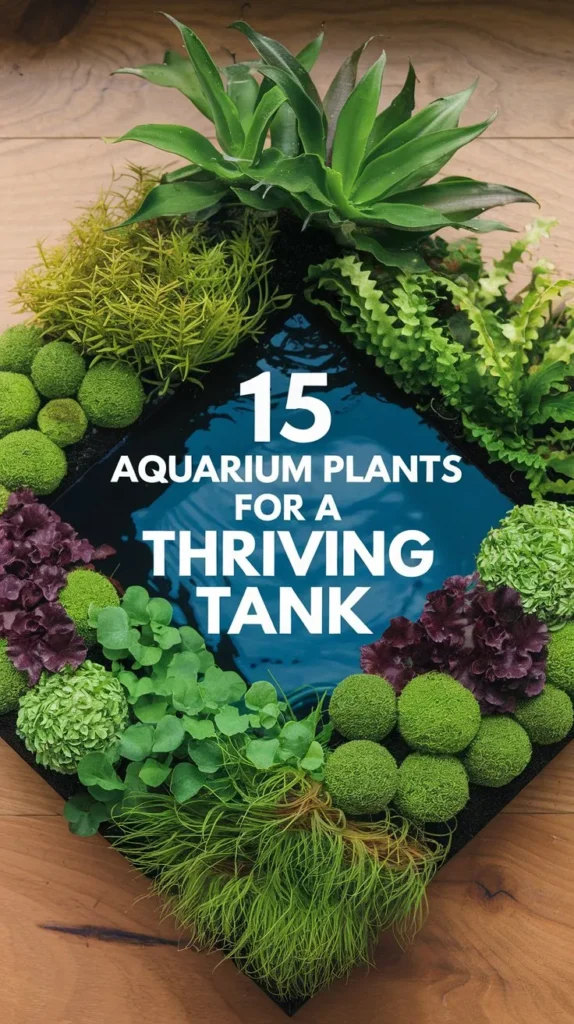
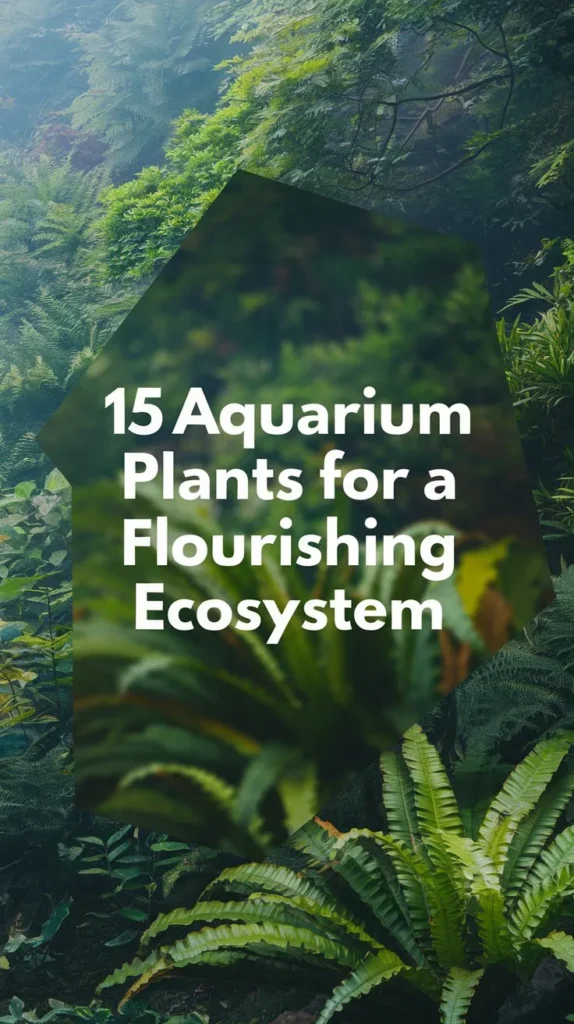
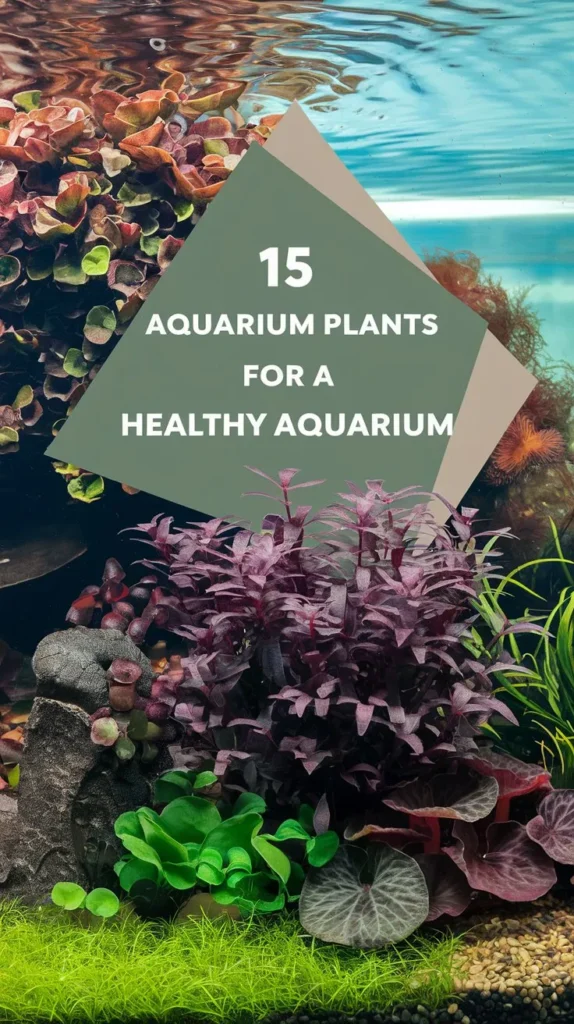
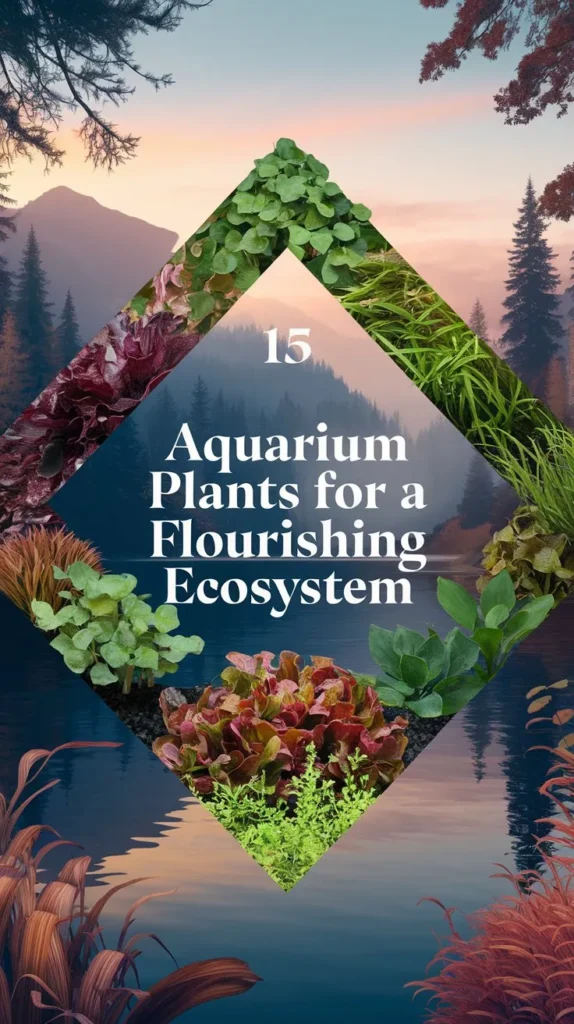
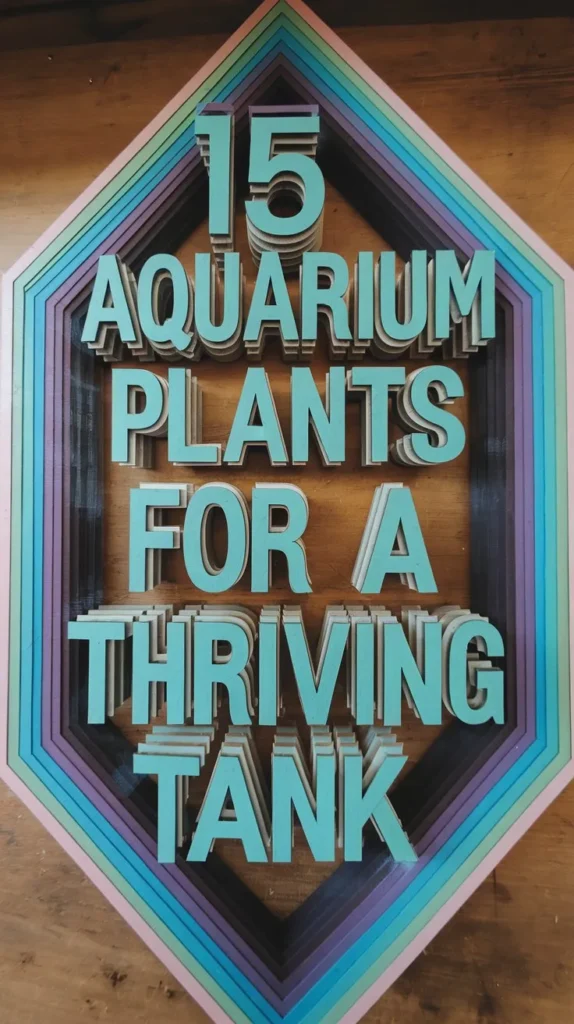
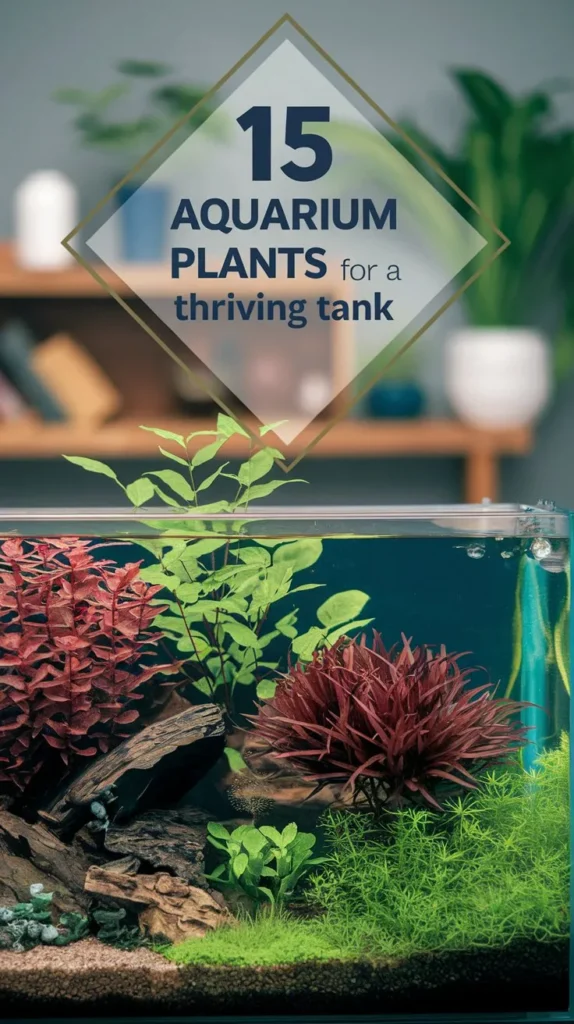
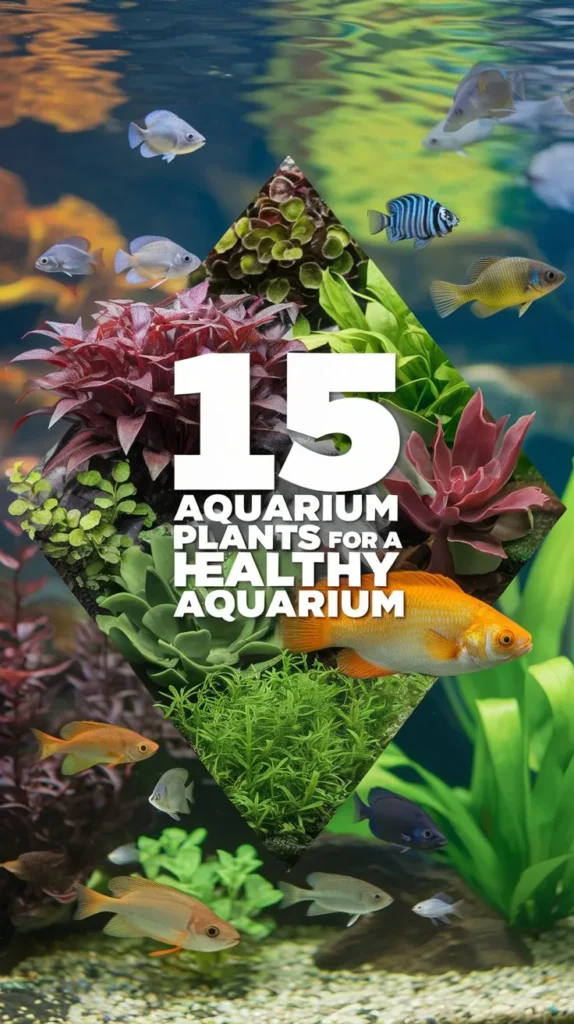
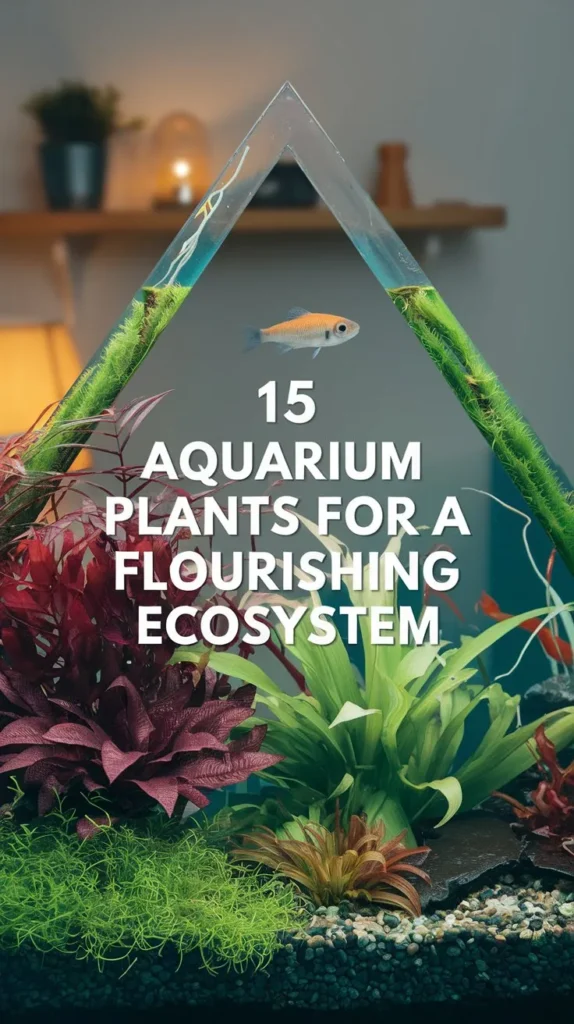
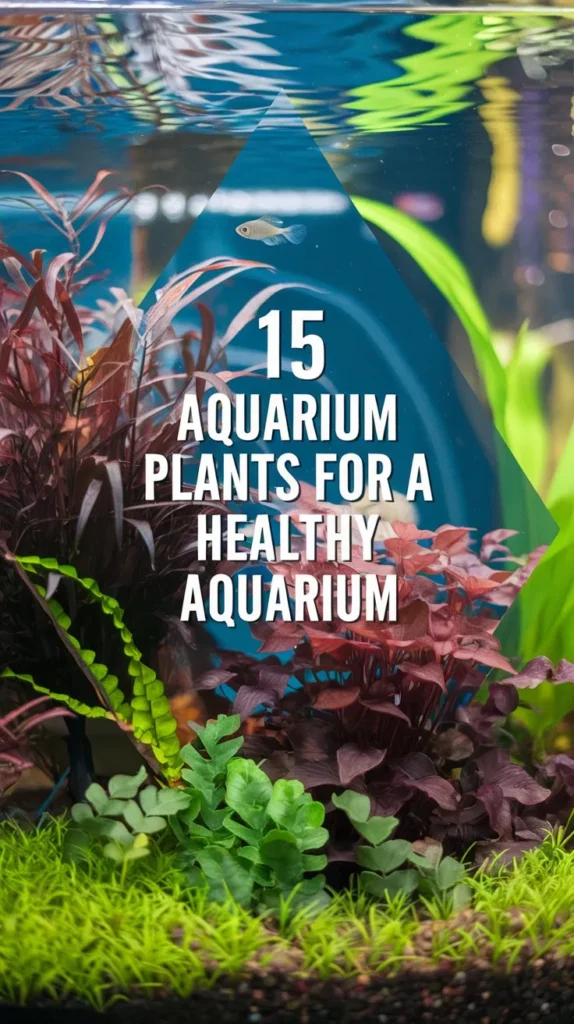
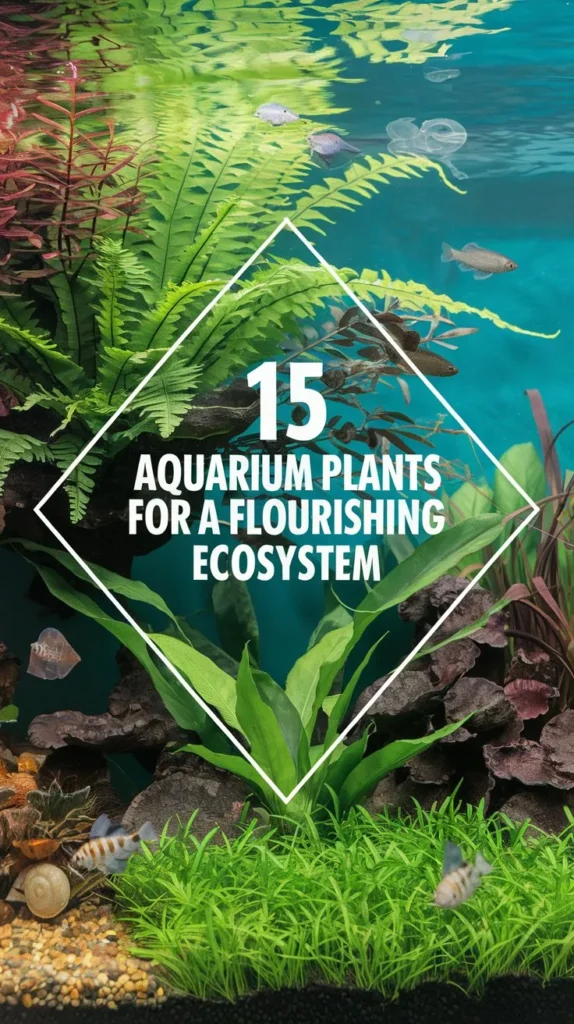

Hello, I’m Aria Cooper, the heart and soul behind Swimmy Buddies. As a devoted fish aficionado, I share my aquatic adventures and expertise to inspire your own underwater explorations. 🐠🌊

